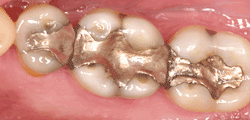Fillings

Providing Dental Fillings in Ann Arbor, MI
Traditional dental restoratives, or fillings, include gold, porcelain, and composite. The strength and durability of traditional dental materials make them useful for situations where restored teeth must withstand extreme forces that result from chewing, often in the back of the mouth.
Newer dental fillings include ceramic and plastic compounds that mimic the appearance of natural teeth. These compounds, often called composite resins, are usually used on the front teeth where a natural appearance is important, but they can also be used on the back teeth depending on the location and extent of the tooth decay.
What's right for me?
Several factors influence the performance, durability, longevity and expense of dental restorations, including:
- The components used in the filling material
- The amount of tooth structure remaining
- Where and how the filling is placed
- The chewing load that the tooth will have to bear
- The length and number of visits needed to prepare and adjust the restored tooth
Before your treatment begins, your doctor will discuss with you all of your options and help you choose the best filling for your particular case. In preparation for this discussion it may be helpful to understand the two basic types of dental fillings — direct and indirect.
- Direct fillings are fillings placed into a prepared cavity in a single visit. They include glass ionomers, resin ionomers, and composite (resin) fillings. The dentist prepares the tooth, places the filling, and adjusts it in one appointment.
- Indirect fillings generally require two or more visits. They include inlays, onlays, veneers, crowns, and bridges fabricated with gold, base metal alloys, ceramics, or composites. During the first visit, the dentist prepares the tooth and makes an impression of the area to be restored. The dentist then places a temporary covering over the prepared tooth. The impression is sent to a dental laboratory, which creates the dental restoration. At the next appointment, the dentist cements the restoration into the prepared cavity and adjusts it as needed.
| White (Composite) Fillings | Silver (Amalgam) Fillings |
|---|---|
| Advantages: | Advantages: |
| Appear the same color as the tooth | Long lasting |
| In general, less drilling | Strong |
| Less healthy tooth structure needs to be removed to place the filling | Relatively less expensive |
| Easily fixed if damaged |
|
| Easier to detect decay under the filling |
|
| Will bond with the tooth, giving it more strength |
|
|
|
|
| Disadvantages: | Disadvantages: |
| Require more skill, time and precision to place
For this reason, they may have an increased failure rate |
Do not bond directly to the tooth, requires additional contouring to help the filling “stick” to the tooth |
| May be an increased out of pocket expense on back teeth | Gray/Silver appearance is visible, also stain the tooth over time |
| May not be the best option for all restorations | Large fillings can lead to a premature fracture in the tooth |
|
|
More healthy tooth structure needs to be removed to place the filling |
|
|
More drilling |
Amalgam fillings contain mercury, does that mean they are dangerous?
Mercury is a natural substance that occurs in nature. Research from the FDA has shown the exposure to mercury from amalgam fillings is less than the amount most people are exposed to in the daily environments and in the food they eat.
Will my insurance cover a white filling?
Every insurance policy is different, so there is not one simple answer to this question. Generally, most insurance policies consider white fillings on back teeth as a cosmetic procedure. This will result in a downgrade of the benefits to cover the amount of a silver filling instead. This may result in an additional expense to the patient. The additional cost can be anywhere from $0 to over $100 per tooth for a white filling. If you prefer a white filling, it would be better to consider your benefits as helping you with the cost of a cosmetic choice.
To learn more about the treatment of cavities listen to our interviews with Dr. Sud that aired on the Smile Files.



 Website Powered by Sesame 24-7™
Website Powered by Sesame 24-7™